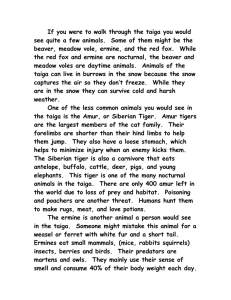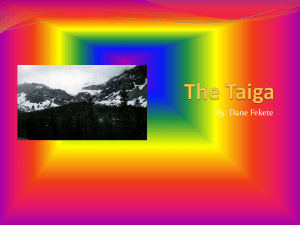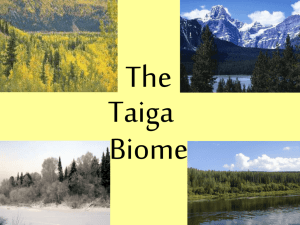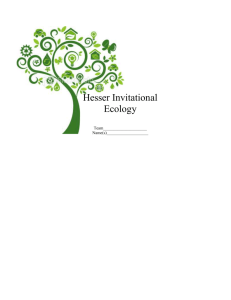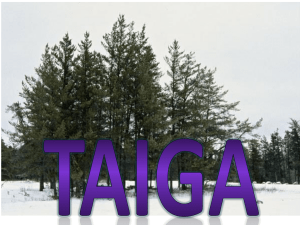taigapower - WordPress.com
advertisement
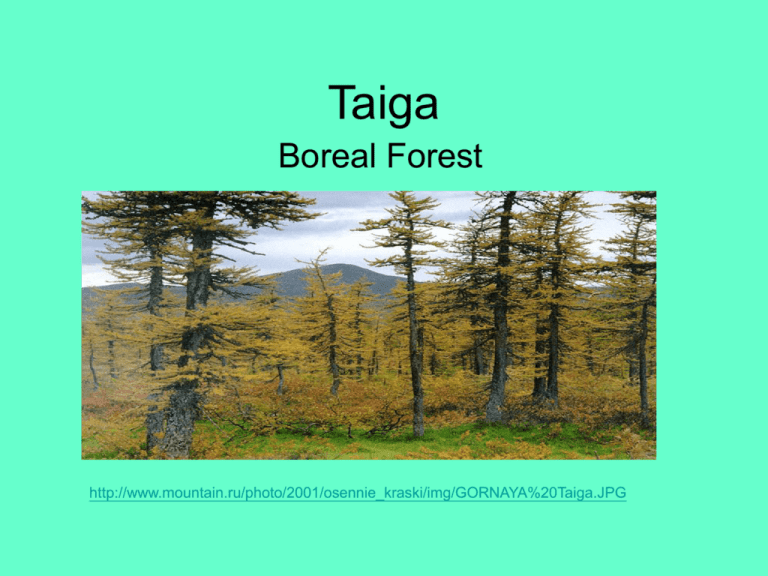
Taiga Boreal Forest http://www.mountain.ru/photo/2001/osennie_kraski/img/GORNAYA%20Taiga.JPG Description of the ecosystem The biome Taiga, also known as the Boreal forest, can be described as the places where most people would stay away from. Taiga’s summers are short and cool, and the winters, are killers. However dislikable it may be, the Taiga is still the world's largest terrestrial biome. The Taiga http://www.tqnyc.org/NYC063000/taiga1.jpg http://images.botany.org/set-01/01-027v.jpg World locations The locations of Taiga range from all the cold places one could think of: Alaska, Canada, Sweden, Finland, inland Norway and Russia, as well as the extreme northern parts in the U. S. (e.g. Northern Minnesota), northern Kazakhstan and Japan’s Hokkaido. http://rst.gsfc.nasa.gov/Sect3/taiga_location_map001.jpg Climate The climate of Taiga is classified as the subArctic climate. It consists of short-period, cool summers and the terrible long, snowy winters. Annual Precipitation • The annual precipitation is from low to moderate. And the range is of 250 to 500 mm across the Taiga Plains, (which are centered in around the Mackenzie River in the western Northwest Territories in Canada) and the western Taiga Shield ecozones, (located eastward from the Taiga Plains) and up to 1000 mm elsewhere. • The higher precipitation is along the coast of Labrador (a region of Atlantic Canada). This is the result of the cooling of moisture-laden air masses rising over the high terrain. Taiga’s annual snowfall is generally in excess of 150 cm, with both snow and ice covering for 6–8 months. Taiga Plains Taiga Shield ecozones Temperatures The temperatures in those areas of Taiga generally range from 0°C to -10°C, with average temperatures of January ranging from -30°C to -15°C and average temperatures of July from 10°C to 15°C. In winter times the temperatures drop to 50°C, and in the summer it rises up to 35°C. Soils Soils in the ranges of Taiga vary considerably, but generally they are classified as acidic, thin and nutrient-poor soils. In the Taiga Plains ecozones, the soils are stony, while on the other hand the valleys of the Mackenzie, Liard, and Hay rivers, where silt deposits have created deeper, nutrient-rich soils. Plant Life The land of Taiga, being poor in nuritence, consists of few plant life. The survivors are the coniferous trees with pointy needles, such as pine, spruce, hemlock, and fir trees. Taigas also have some smallleaved deciduous trees like birch, alder, willow and aspen and in the southernmost part of the taiga also has trees like oak, maple and elm scattered among the conifers. Balsam Fir is the third most common tree of the Taiga. It is the tallest tree in the Boreal Forest and it grows 40-80 feet high http://tree-city.net/images/BalsamFir1.jpg Animal Life The cold climate of the Taiga prevents many animals from living there year-round. So just like its plants, there are not many animals living in the Taiga areas. Some of the large animals include moose, deer, and bears. Examples of other smaller animals that live in the taiga are bobcats, squirrels, chipmunks, ermine, and moles and lynxes. The taiga is home to many birds such as the bald eagle, chickadee, woodpeckers, and warblers. The Canadian Lynx is one of three wild cats that are known by the common name Lynx. http://home.mcn.net/~wtu/images/lynx2.jpg Further information Blue Planet Biomes: http://www.blueplanetbiomes.org/taiga.htm World Wildlife Fund - Coniferous Forests: www.panda.org/news_facts/education/middle_school/habitats/coniferous_forests.cfm Earth Floor - Taiga: www.cotf.edu/ete/modules/msese/earthsysflr/taiga.html

